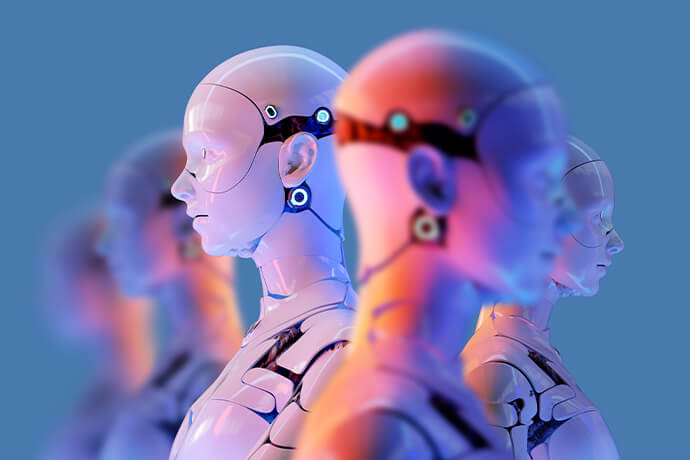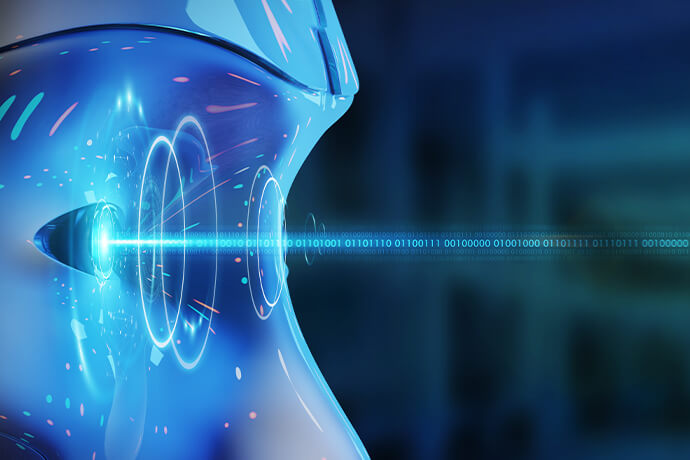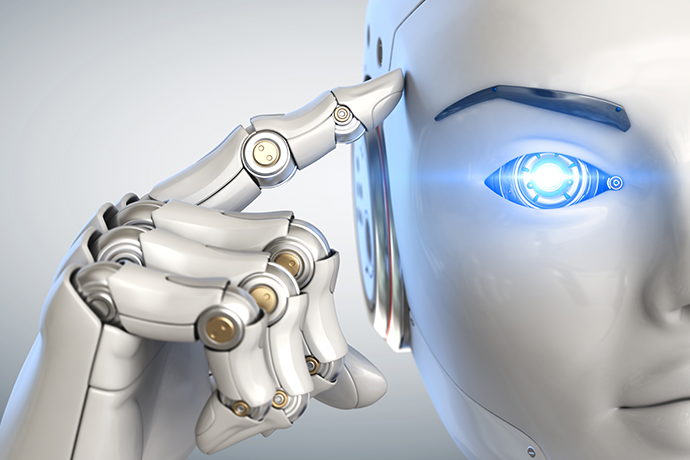 SPEAKERS
SPEAKERS
 TOPICS
TOPICS
What is artificial intelligence and what is machine learning used for? This informative guide has all the answers to your questions about AI.

Artificial intelligence (AI) plays an increasingly integral role in the way we live. But what is AI technology and what is artificial intelligence used for?
In this guide to artificial intelligence we’ll explain the what, the how and the future of AI. We’ll also discuss how AI is used in different industries such as education, biotech, finance. Outline the many benefits it offers as well as solving many business problems.
‘A type of computer technology which is concerned with making machines work in an intelligent way.(Collins Dictionary) Similar to the way that the human mind works.’ In basic terms, AI and machine learning models simulate human intelligence, using machines and digital systems to replicate human behaviour.
AI enables machines to carry out tasks that would be completely by human beings. Different types include machine learning, neural networks and deep learning. Technologies associated include computer vision, natural language processing and graphical processing units.
Over the course of history, thanks to data scientists, AI applications have developed, evolved and diversified. Artificial intelligence is now used across multiple industries within an incredibly diverse range of fields. Speech recognition, retail and automated trading for investors using labelled data and unlabeled data.
Artificial intelligence covers a broad spectrum of tasks, some of which are highly specific and others more general.
Narrow, AKA weak AI: focuses on one element, job or task.
General intelligence, AKA strong AI: replicates human intelligence, enabling machines to do everything humans can.

During the 1940s and 50s, Alan Turing started asking questions about the possibility of computers behaving like humans through learning experiences. The ‘artificial intelligence’ wasn’t coined until 1956. The phrase was heard for the first time at a conference in the US.
Supervised machine learning was primarily employed for problem-solving and street mapping in the 1960s and 1970s. . In 1997, IBM celebrated a seminal moment when its computer, Deep Blue, won a chess match against the grandmaster, Garry Kasparov.
In the early 2000s, DARPA created a personal assistant. A decade later Amazon released its virtual assistant, Alexa. A point at which AI arguably became integral to our day to day.
Between 2014 and 2020, Amazon sold over 100 million Alexa devices (source). During the same period, iPhone users became familiar with Siri and Microsoft users were introduced to Cortana.
In the last 20 years, AI systems have become increasingly influential. It is now used across a vast range of applications globally, offering benefits and opportunities for individuals and organisations. As technology evolves, the future looks bright for AI and machine learning.
Artificial intelligence is used across an increasing number industries. Here are some of the most common and important uses of AI within different sectors and fields:
AI research benefits many industries medicine and healthcare being perhaps one of the most crucial and promising ones.
AI offers benefits for healthcare providers, professionals, students and patients. Examples of applications include:
These points demonstrate the capabilities of AI within the field of healthcare. Using AI, healthcare professionals gain access to tools and systems that aid treatment planning and facilitate early diagnosis. They can also utilise AI to enhance accuracy.
Figures from the American Cancer Society demonstrate clearly that AI is 30 times faster than humans when reviewing mammograms. It offers 99% accuracy (source). Students can benefit from training systems and scenarios that enable them to hone their skills. Surgeons can use cutting-edge technology to complete otherwise impossible procedures efficiently and with ease.
Another area that has taken off is preventative care. AI is helping millions of people to make healthier lifestyle choices through devices and apps that monitor health. They make suggestions to reduce the risks of health issues.
Artificial intelligence in retail offers advantages for customers and retailers. Research suggests that use of AI in retail is set to increase. Approximately 6 fold between 2021 & 2028 from $4.8 billion to over $31 billion.(source). Here are some examples of how AI is used in retail:
By using AI technology, retailers can increase ROI, create high-quality leads and boost efficiency and CX . Customers benefit from customised suggestions, thanks to tools like recommendation engines as well as simple, quick checkout processes and targeted marketing.
AI has become increasingly integral in applied sciences offering a wide range of benefits. These include: processing huge amounts of data quickly, reducing the cost of clinical trials and providing virtual services. Applications include:
Studies suggest that almost 50% of learning tools will offer AI capabilities by 2025 (source). AI has an expansive range of uses and benefits for educators and students. Here are some key advantages and examples of how AI is used in the education sector:
Advantages for students:
Benefits for teachers and educators:
Gaming is one area where AI is contributing to fascinating developments. For gamers, the use of AI offers enhanced experiences and added excitement. Uses of AI in gaming include:
AI offers a wealth of benefits for banks and financial organisations. These include overcoming unique industry challenges, improving customer experience and addressing common pain points. Examples include: fraud detection reduction, optimising client experience to attract and retain customers and speeding up banking processes. Benefits include:
Artificial intelligence is used for a variety of purposes within the field of human resources (HR). The primary benefits include saving time and boosting efficiency through automated tasks. Whilst also using virtual communications and identifying suitable candidates to speed up the recruitment process.
HR professionals can automate repetitive administration costs to free up time to focus on core tasks. They can use AI to respond to common queries through chatbots as well as simplify and accelerate recruitment tasks. AI is particularly advantageous for HR departments that process high volumes of applications and enquiries.
For employees, AI offers a quick and simple way to access help and support. It can also provide benefits in the form of tailor made recommendations and suggestions, training pathways and developing skills.

AI is more influential than ever, but what benefits does it offer us? Artificial intelligence can make our lives easier and provide access to a whole host of opportunities. These include:
One of the most significant benefits of AI for humans is the ability to boost efficiency. We can free up time by using innovative technologies that do jobs faster, take on complex tasks.
AI development doesn’t have the limitations or restrictions of the human brain or body. It can be used in tandem with human capabilities to save time and effort.
Data is incredibly valuable, but it can be challenging to capture the benefits of collecting and analysing information. Mainly due to a lack of time and human resources. AI provides organisations and businesses with the capacity to process massive amounts of data quickly, providing important insights across all sectors.
Making decisions when you don’t have the jigsaw pieced together is difficult and it carries risks. AI helps this process by making easier deeper data analysis, using modelling and analysing trends.
Adding AI capabilities enables the development and evolution of existing technologies and products, expanding applications and offering additional advantages.
Vice president of IBM Quantum, Dr Jay Gambetta, describes quantum computing as “a new kind of computing. Using the same physical rules that atoms follow in order to manipulate information.” Quantum computing utilises maths calculations that go above and beyond the capabilities of even the most advanced computers.
When discussing AI and quantum computing, it’s mind blowing to fathom the future potential. Computer hardware is still one area that needs more research. It is relatively early days for AI and quantum computing as a collective force. It may be possible to speed up tasks by merging these two technologies to attempt tasks that were previously deemed impossible.
AI is increasingly integral to the processes we subscribe to as we live, learn and work. It is increasingly visible but it has not yet reached its full potential. As technology advances,it will become even more powerful and influential.
Short term trends Trends include more machines and robots replacing humans to execute repetitive, manual tasks. This would undoubtedly result in reduced size of human workforces.
Another important development is the use of AI to optimise outcomes in healthcare, biotech and research. As more institutions adopt this technology, it will become easier to develop new drugs& perform new procedures. These will ultimately help save more lives thanks to early detection and preventative action.
There is a great deal of debate surrounding AI and its impact on talent and recruitment. One issue is people losing their jobs because of a direct result of automation. While replacing human employees with machines is inevitable in some industries, there could be a silver lining.
Losing jobs that revolve around routine tasks could inspire a shift towards sectors and roles that are more human centric. There are many jobs that machine learning imbued computer systems cannot do. People who are at risk of unemployment could be encouraged to explore other avenues and retrain, for example.
Artificial intelligence is a term that was coined in 1956. It is a branch of computer science that involves creating systems and machines capable of performing tasks usually associated with humans. AI is simply computers simulating human activity.
It is used widely across multiple industries, including healthcare, medicine and bio-tech, education and retail. Offering a broad spectrum of benefits. AI improves accuracy, saves time and effort( algorithms learn fast).
It automates repetitive tasks (linear regression) and enhances client, patient or customer experiences. Building on existing processes, systems and products to expand capabilities.